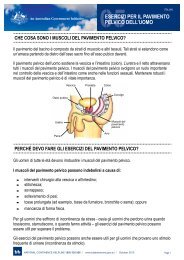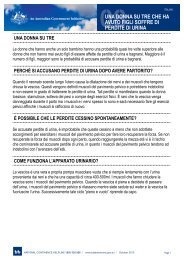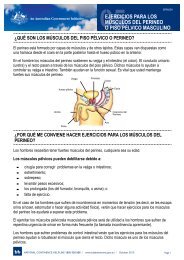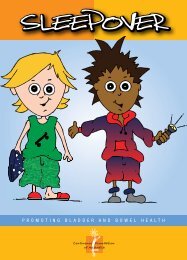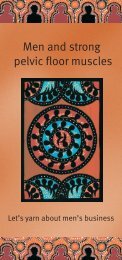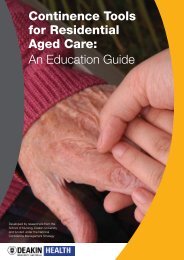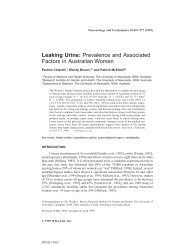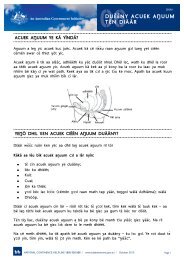Pharmacy Continence Care - Bladder and Bowel Website
Pharmacy Continence Care - Bladder and Bowel Website
Pharmacy Continence Care - Bladder and Bowel Website
You also want an ePaper? Increase the reach of your titles
YUMPU automatically turns print PDFs into web optimized ePapers that Google loves.
Social/Relationships<br />
Participation in social activities outside your home 33.3 46.7<br />
Emotional Health<br />
Emotional health (nervousness, depression, etc) 36.7 36.7<br />
Feeling frustrated 40.0 50.0<br />
Table 2: Consumer responses to IIQ-7 index of life impact of urinary incontinence<br />
Physical health<br />
When respondents were asked how urine or bowel leakage affected their physical health, the<br />
following outcomes were reported:<br />
• Skin Problems/Skin Breakdown: close to three-quarters of all respondents (78 per cent in<br />
baseline survey vs. 73 per cent in follow-up survey) had not been affected by skin<br />
problems/skin breakdown. The majority of those affected were only slightly or<br />
moderately affected (17 per cent vs. 23 per cent). A minority (5 per cent vs. 3 per cent)<br />
were greatly affected<br />
• Infections/Ulcerations: about eight in ten respondents (78 per cent vs. 83 per cent) had<br />
not been affected by infections/ulcerations. Those affected were most likely to be slightly<br />
or moderately affected (20 per cent vs. 10 per cent) as opposed to greatly affected (3<br />
per cent vs. seven per cent)<br />
• Hygiene: of all areas measured, hygiene was identified as the most common area<br />
hindering the physical health of participants, affecting, in total, around four in ten (39<br />
per cent vs. 43 per cent). This decreased from 28 per cent (10 respondents) in the base<br />
survey to 20 per cent (6 people) in the follow-up survey, while those moderately or<br />
greatly affected increased from 11 per cent (or four respondents) to 24 per cent (7<br />
respondents)<br />
• Rashes: around seven in ten respondents (67 per cent vs. 73 per cent) were not affected<br />
by rashes as a result of incontinence. Those affected were most likely to be slightly or<br />
moderately affected (22 per cent vs. 20 per cent), compared with those greatly affected<br />
(11 per cent vs. 7 per cent).<br />
<strong>Care</strong>rs<br />
The survey results indicated that carers of those with incontinence spent considerable time<br />
washing bedding <strong>and</strong> clothing as a result of accidental urine loss or leakage from the bowel.<br />
Baseline survey results indicated that around two in ten carers (22 per cent) spent over six<br />
hours per week washing clothing <strong>and</strong> bedding, with four in ten (44 per cent) in the follow-up<br />
survey doing the same.<br />
When carers were asked whether helping someone with incontinence had affected their<br />
emotional health, 29 per cent (5 people) in the baseline survey vs. 56 per cent (5 people) in<br />
the follow-up survey said not at all. Those affected were most likely to report being slightly<br />
affected (65 per cent; 11 people vs. 33 per cent; three people), compared with moderately<br />
(6 per cent; one person in base survey) or greatly affected (11 per cent; one person in<br />
follow-up survey).<br />
Usage <strong>and</strong> purchase of incontinence products<br />
Incontinence disposable pads (81 per cent) were the most commonly utilised products for<br />
incontinence management reported in the baseline survey, followed by special<br />
undergarments (37 per cent), sanitary disposable pads (28 per cent), skincare products (28<br />
per cent) <strong>and</strong> drainage products (14 per cent).<br />
Final Report<br />
41<br />
NOVA Public Policy<br />
<strong>Pharmacy</strong> <strong>Continence</strong> <strong>Care</strong> Project



